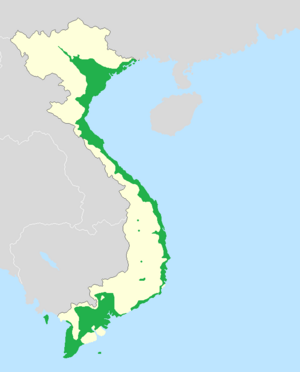Vietnamese language facts for kids
Quick facts for kids Vietnamese |
||||
|---|---|---|---|---|
| Native to | Vietnam | |||
| Native speakers | 75 million (2007)ne2007 | |||
| Language family |
Austro-Asiatic
|
|||
| Writing system | Latin (Vietnamese alphabet) Vietnamese Braille Chữ nôm (used to limited extent) |
|||
| Official status | ||||
| Official language in | Association of Southeast Asian Nations |
|||
| Recognised minority language in | ||||
| Linguasphere | 46-EBA | |||

Natively Vietnamese-speaking (non-minority) areas of Vietnam
|
||||
|
||||
Vietnamese (called Tiếng Việt by its speakers) is the official language of Vietnam. It's spoken by millions of people! Like many other languages in Asia, Vietnamese is a tonal language. This means the meaning of a word can change depending on the pitch of your voice when you say it.
Contents
How Vietnamese Developed
Vietnamese has been greatly influenced by Chinese languages over time. It also shares some history with other languages like Khmer.
Today, Vietnamese uses a Latin alphabet. This alphabet is similar to the one used for French. However, long ago, Vietnamese was written using Chinese characters. This old writing system was called Chữ Nôm. Not many people know how to read or write Chữ Nôm today.
Most Chinese speakers in Vietnam now use regular Chinese writing. But you can still find traditional calligraphy artists. For example, Hồ Chí Minh City has a famous Chinatown area.
Vietnamese often adds new words when they are needed. This happens a lot in fields like engineering, science, and academics. Also, with more media use, some new words from TV, internet, and news are now commonly accepted.
Speaking Vietnamese
The way Vietnamese is spoken can change from one province to another. The further apart two provinces are, the more different their spoken language might sound. For example, there are differences between the way people speak in Hanoi and in the Mekong Delta. These differences are called dialects.
Today, the national education system in Vietnam teaches the Hanoian dialect. However, different ethnic groups in Vietnam might still use their own unique dialects, languages, or vocabulary.
Vietnamese and Computers
There are special computer programs that can speak Vietnamese. For example, a tool for the Firefox web browser can read Vietnamese text aloud. This is called Text-to-Speech (TTS).
Audio libraries are also available to help computers speak Vietnamese. Google translate uses a TTS reader and sound library to read simple Vietnamese sentences. Small electronic translators are also very popular. One well-known company, Kim Tu Dien, makes common portable dictionaries for the Vietnamese market.
Writing Vietnamese
The Alphabet
The Vietnamese alphabet is called "Chữ Quốc Ngữ" in Vietnamese. This means "The National Scripts."
Diphthongs
A diphthong is when two vowels are combined to make one sound. In Vietnamese, diphthongs have special rules. For example, one rule says that the tone for both letters in a diphthong must be the same.
Triphthongs
Vietnamese has more triphthongs (three vowels together) than English. An example is 'uye'.
Vietnamese Syllables
In Vietnamese, a single syllable can often be a whole word. For example, just like in English you can say "go," Vietnamese speakers can use a single syllable. To add more emphasis, a word might be said twice. For instance, "go - go" (Vietnamese: đi đi) means "go now" with more urgency. However, saying "go" just once is also very common.
Many single syllables are used in Vietnamese. They can form complete sentences without needing to be paired with other syllables, unlike in Chinese. Still, readers and speakers will notice that many syllables in most sentences are often paired up.
Making Words Sound Vietnamese (Vietnamization)
Many words from other languages are used in Vietnamese. For example, "Sushi" is a word used in most languages around the world. When a word is "vietnamized," it means it's changed to sound more like Vietnamese. China does something similar: "Ao-da-li-ya" in Pinyin means Australia.
One main rule for vietnamization is that Vietnamese words or syllables are usually not broken up by a consonant. For example, "Việt Nam" is written as two separate words. An example of how a foreign word is broken into two syllables is "mô tô". This is a vietnamized version of "motor" and "auto" (which becomes "ô tô"). However, there are exceptions, like "lôgic".
When a new foreign word is introduced, people will often say it in a vietnamized way at least once. This helps Vietnamese listeners understand it better.
- This rule helps explain why the family name Nguyễn is not pronounced like "New Yen." The y in Vietnamese is a vowel sound, similar to the 'y' in English words like "many" or "penny."
Another rule for vietnamization is that the sound of each syllable should be made a bit closer to Vietnamese sounds. Tone marks are added to vowel letters. For example, "lôgic" is a change from "logic" and would be needed for some subjects.
Exceptions
Sometimes, foreign words are not vietnamized. Names like Barack Obama or Bill Clinton might be attempted by Vietnamese speakers, but in writing, these foreign names usually stay the same. Names like David are easy for Vietnamese people to say, so they have become very popular in English writing.
Vietnamese Grammar
Exclamations
Exclamations are very popular in Vietnamese. People often use exclamations to start what they are saying. They might also add a quick exclamation after they say something. These exclamations can show a feeling or just be a simple expression.
Conjunctions
Conjunctions (words like "and," "but," "or") are used in Vietnamese, just like in English.
Images for kids
See also
 In Spanish: Idioma vietnamita para niños
In Spanish: Idioma vietnamita para niños



